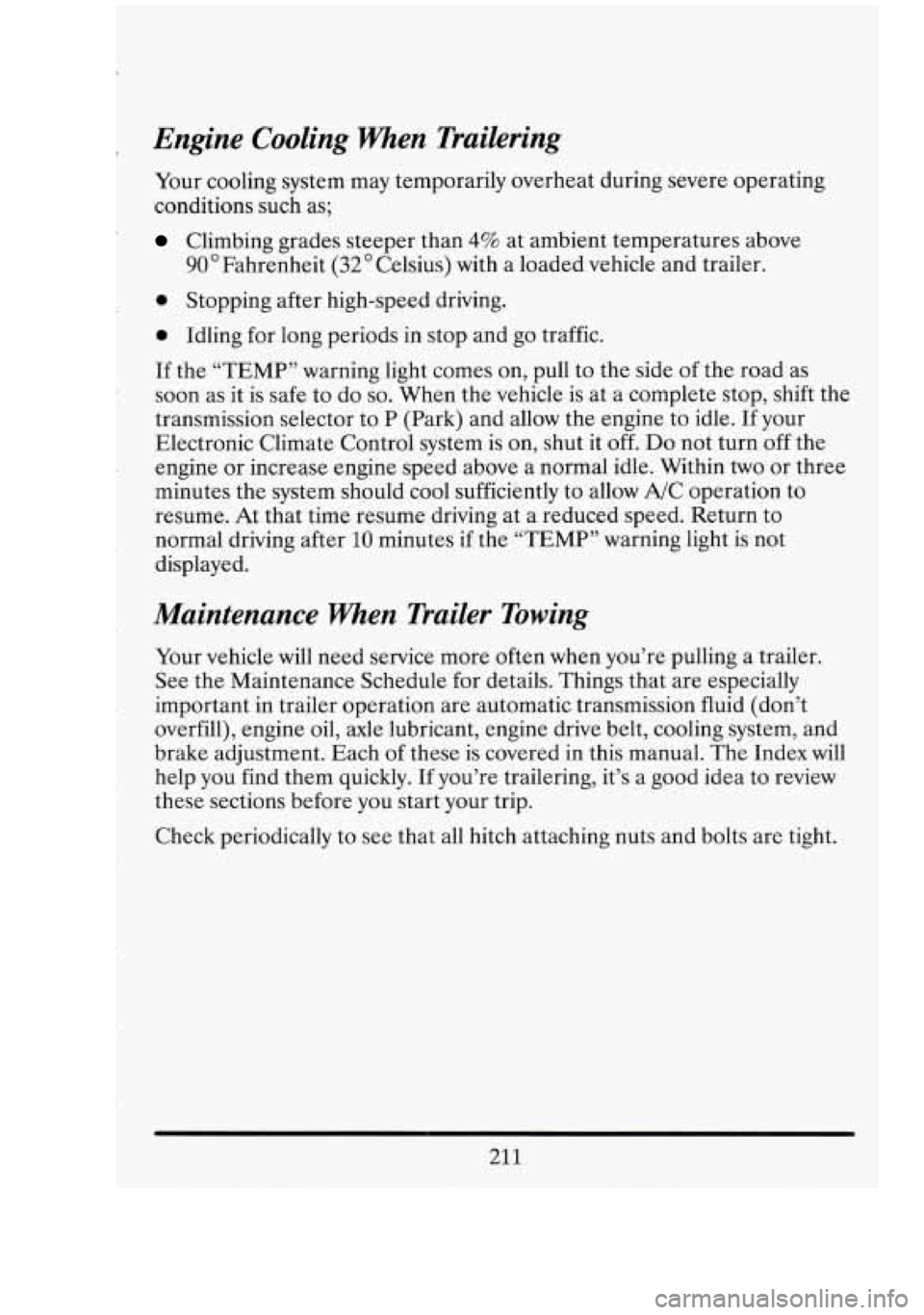Page 210 of 398
Include an ice scraper, a small brush or broom, a supply of windshield
washer fluid, a rag, some winter outer clothing, a small shovel,
a
flashlight, a red cloth, and a couple of reflective warning triangles. And, if
you will be driving under severe conditions, include a small bag of sand, a
piece
of old carpet or a couple of burlap bags to help provide traction. Be
sure you properly secure these items in your vehicle.
Driving on Snow or Ice
197
Page 224 of 398

Engine Cooling When Trailering
Your cooling system may temporarily overheat during severe operating
conditions such as;
Climbing grades steeper than 4% at ambient temperatures above
90’Fahrenheit (32O Celsius)
with a loaded vehicle and trailer.
0 Stopping after high-speed driving.
0 Idling for long periods in stop and go traffic.
If the “TEMP” warning light comes on, pull
to the side of the road as
soon as it is safe to do
so. When the vehicle is at a complete stop, shift the
transmission selector to P (Park) and allow the engine to idle. If your
Electronic Climate Control system is on, shut it
off. Do not turn off the
engine or increase engine speed above a normal idle. Within
two or three
minutes the system should cool sufficiently to allow A/C operation to
resume. At that time resume driving at a reduced speed. Return to
normal driving after
10 minutes if the “TEMP” warning light is not
displayed.
Maintenance when Trailer Towing
Your vehicle will need service more often when you’re pulling a trailer.
See the Maintenance Schedule for details. Things that are especially
important in trailer operation are automatic transmission fluid (don’t
overfill), engine oil, axle lubricant, engine drive belt, cooling system, and
brake adjustment. Each of these is covered in this manual. The Index will
help you find them quickly. If you’re trailering, it’s a good idea to review
these sections before you start your trip.
Check periodically to
see that all hitch attaching nuts and bolts are tight.
21
1
Page 226 of 398
ELUARD WMING FLASHERS
Your hazard warning flashers let you warn others. They also let police
know you have a problem. Your front and rear turn signal lights will flash
on and off.
I
I
make your front and
rear turn signal lights
flash on and off.
Your hazard warning flashers work no matter what position your key is in,
and even
if the key isn’t in.
Page 227 of 398
I
To turn off the
flashers,
pull out on
the collar. When the
hazard warning
flashers are on, your
turn signals won't
work.
Dl
OTHER WNING DE'C.ICES
If you carry reflective triangles, you can set one up at the side of the road
about
300 feet (100 ,m) behind your vehicle.
JUMP STARTING
If your battery has run down, you may want to use another vehicle and
some jumper cables to start your Cadillac. But please follow
the steps
below to do it safely.
E!
214
Page 236 of 398
r_ ENGINE O'VERHEATING
You will find the warning light about a hot engine on your Cadillac
instrument panel.
If Steam Is Coming From Your Engine
-
223
Page 237 of 398

NOTICE:
If your engine catches fire because you keep driving with no
coolant, your vehicle can be badly damaged. The costly repairs \
would not be covered by your warranty.
IfNo Steam Is Coming From Your Engine
If you get the overheat warning but see or hear no steam, the problem
may not be too serious. Sometimes the engine can get a little too hot
when you:
0 Climb a long hill on a hot day.
Stop after high speed driving.
0 Idle for long periods in traffic.
Tow a trailer.
I
If you get the overheat warning with no sign of steam, try this for a
minute or
so:
i3‘ I
1. Turn off your air conditioner.
2. Turn on your heater to full hot at the highest fan speed and open the
3. If you’re in a traffic jam, shift to “N” (Neutral).
window
as necessary.
If you no longer have the overheat warning, you can drive. Just to be safe,
drive slower
for about ten minutes. If the warning doesn’t come back on,
you can drive normally.
If the warning continues, pull over, stop, and park your vehicle right
away.
If there’s still no sign of steam, you can idle the engine for two or three
minutes while you’re parked, to see if the warning stops. But then, if you
still have the warning, TURN
OFF THE ENGINE AND GET
EVERYONE OUT OF THE VEHICLE until it cools down.
You may decide not to lift the hood but to get service help right away.
3
224
Page 245 of 398
> 2 L- "- " -
^', If a tire goes.flat, avoid farther tire and wheel damage bv driving slowly to
,' a level place. Turn on your hazard warning flashers.
Page 255 of 398
Align the upper
locator pins and insert
the pins into the holes. I
i-1 1;l
Push the handles up to lock the skirt in place.
I COMPACT SPARE TIRE
Although the compact spare was fully inflated when your vehicle was
new, it can lose air after a time. Check the inflation pressure regularly. It
should be
60 psi (420 Pa). The compact spare is made to go up to 3,000
miles (5000 km), so you can finish your trip and have your full-size tire
repaired or replaced where you want.
Of course, it’s best to replace your
spare with a full-size tire as soon
as you can. Your spare will last longer
and be in good shape in case you need it again.
Your anti-lock brake system warning light may come on when you are
driving with
a compact spare. See “Anti-Lock Brake System Warning
Light” in the Index.
242 I
CII
i